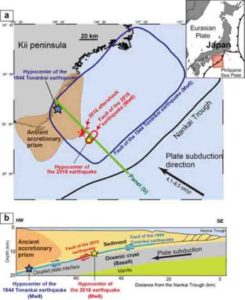
The islands of the Japanese archipelago are affected both by frequent, low-magnitude earthquakes and tremors and by larger, highly destructive events. One of the largest quakes to strike Japan occurred in 1944, leading to the loss of more than 1,200 lives on the main and most populated island of Honshu. Its strength resulted from the abrupt release of plate tectonic forces, a process known as subduction, centered on an area beneath Honshu where it slides over the top of oceanic crust.
Highly destructive earthquakes caused by subduction occur because of excessive friction that develops during the sliding process, resulting in a build-up of stress. Sudden release of this stress, a condition called rupturing, leads to the violent shaking felt during an earthquake. A recent study led by the International Institute for Carbon-Neutral Energy Research (I2CNER) at Kyushu University in Japan, and published in Earth and Planetary Science Letters, now sheds new light on this stress build-up in tectonic plates. The focus was on the Nankai Trough, one of three major subduction zones offshore of Japan.
“Our understanding of the dynamic behavior of plate boundary faults has advanced,” the study’s lead author Takeshi Tsuji says. “Yet the factors that control the build-up of friction and stress along plate interfaces and in co-seismic zones are less established.”
The researchers used advanced 2D and 3D seismic profiles to reveal the detailed structure of the Nankai Trough, particularly of an ancient accretionary prism — a large mass of rock and sediment accumulated in the trough.
The added mass of this rock and sediment has impeded subduction, ultimately causing stress to build up over time. This stress build-up, and rupturing, was the root cause of the massive 1944 Tonankai earthquake and the smaller Off-Mie earthquake that struck almost the same area on April 1, 2016.
“Along with evidence of frictional obstruction to subduction,” Tsuji says, “the fault structure appears to have also impacted earthquake location and behavior. We found that aftershocks of the 2016 quake only occurred in front of the accretionary prism, where stress accumulation is greatest.”
The long-term implications of the study hinge on evidence that the pre-existing faults from the 1944 earthquake have strongly influenced the orientation and location of rupturing during the 2016 event, suggesting that large earthquakes in Japan are most likely to occur in this very same region of the Nankai Trough in the future.
Reference:
Takeshi Tsuji, Shohei Minato, Rie Kamei, Tetsuro Tsuru, Gaku Kimura. 3D geometry of a plate boundary fault related to the 2016 Off-Mie earthquake in the Nankai subduction zone, Japan. Earth and Planetary Science Letters, 2017; 478: 234 DOI: 10.1016/j.epsl.2017.08.041
Note: The above post is reprinted from materials provided by Kyushu University, I2CNER.










